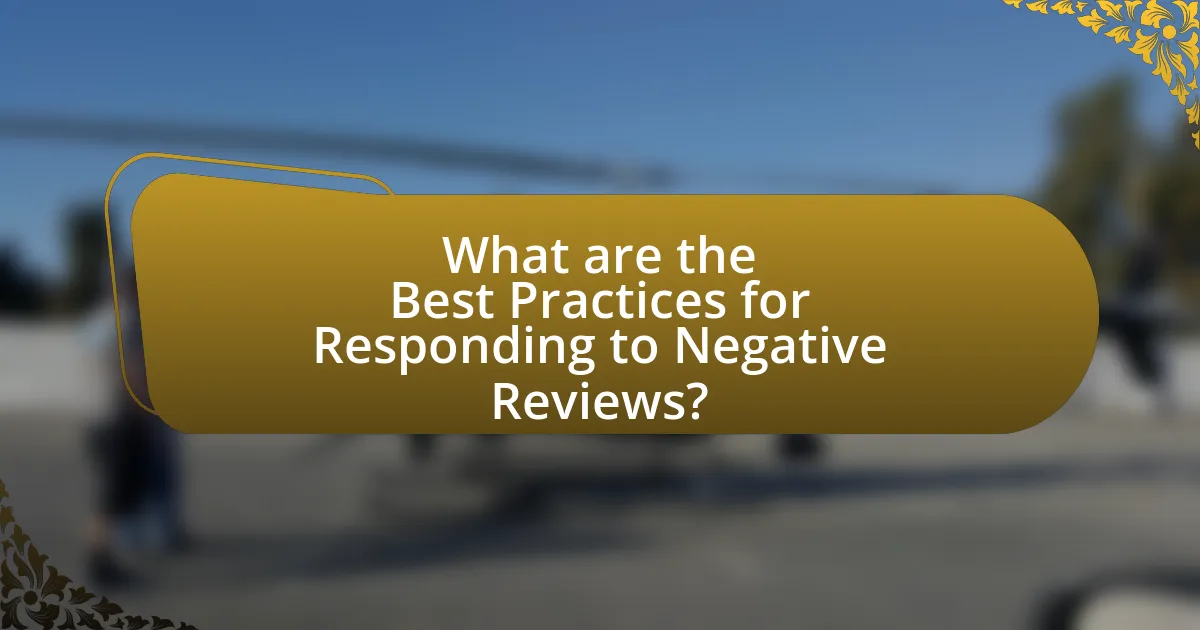The article focuses on best practices for responding to negative reviews, emphasizing the importance of acknowledging customer concerns, offering sincere apologies, and providing effective solutions. It outlines the critical elements of an effective response, including empathy and professionalism, while highlighting the potential consequences of ignoring negative feedback. Additionally, the article discusses strategies for preparing for negative reviews, the role of staff training, and how businesses can leverage negative feedback for improvement. By implementing these practices, companies can enhance their reputation, foster customer loyalty, and ultimately drive business growth.

What are the Best Practices for Responding to Negative Reviews?
The best practices for responding to negative reviews include acknowledging the issue, apologizing sincerely, providing a solution, and inviting further communication. Acknowledging the issue shows that the business values customer feedback, while a sincere apology can help to diffuse the situation and demonstrate empathy. Providing a solution not only addresses the customer’s concern but also showcases the business’s commitment to improvement. Inviting further communication allows for a more personalized resolution and can turn a negative experience into a positive one. Research indicates that 70% of customers who receive a response to their negative review are likely to return to the business, highlighting the importance of effective engagement.
Why is it important to respond to negative reviews?
Responding to negative reviews is crucial for maintaining a positive brand image and customer trust. Engaging with dissatisfied customers demonstrates that a business values feedback and is committed to resolving issues, which can lead to improved customer loyalty. According to a study by Harvard Business Review, businesses that respond to reviews can increase their ratings by an average of 0.12 stars, which significantly impacts consumer purchasing decisions. Additionally, addressing concerns publicly can showcase a company’s dedication to customer satisfaction, potentially converting unhappy customers into advocates.
How can responding to negative reviews impact a business’s reputation?
Responding to negative reviews can significantly enhance a business’s reputation by demonstrating accountability and commitment to customer satisfaction. When businesses address complaints publicly, they show potential customers that they value feedback and are willing to resolve issues, which can lead to increased trust. According to a study by Harvard Business School, businesses that respond to reviews can see an increase in ratings by up to 0.12 stars, which correlates with a 5-9% increase in revenue. This indicates that proactive engagement with dissatisfied customers not only mitigates damage but can also improve overall perception and attract new clientele.
What are the potential consequences of ignoring negative reviews?
Ignoring negative reviews can lead to significant reputational damage for a business. When a company fails to address customer complaints, it risks losing potential customers who may be influenced by the negative feedback. Research indicates that 70% of consumers trust online reviews as much as personal recommendations, highlighting the impact of negative reviews on purchasing decisions. Additionally, ignoring these reviews can result in decreased customer loyalty, as customers may feel undervalued and unacknowledged. This can ultimately lead to a decline in sales and market share, as dissatisfied customers are likely to share their experiences with others, further amplifying the negative perception of the brand.
What are the key elements of an effective response?
The key elements of an effective response to negative reviews include acknowledgment, empathy, resolution, and professionalism. Acknowledgment involves recognizing the reviewer’s concerns, which shows that the business values customer feedback. Empathy is crucial as it demonstrates understanding of the reviewer’s feelings, fostering a connection. Resolution entails offering a solution or a way to rectify the issue, which can help restore customer trust. Professionalism ensures that the response maintains a respectful tone, regardless of the review’s nature, reflecting positively on the business. These elements collectively contribute to a constructive dialogue that can enhance the business’s reputation and customer relationships.
How should tone and language be adjusted when responding?
Tone and language should be adjusted to be empathetic and professional when responding to negative reviews. Empathy helps to acknowledge the reviewer’s feelings, while professionalism maintains the brand’s reputation. For instance, using phrases like “I understand your frustration” demonstrates empathy, and maintaining a respectful tone ensures that the response reflects well on the business. Research indicates that businesses that respond to negative reviews with a positive tone can improve customer perceptions and loyalty, as seen in a study by the Harvard Business Review, which found that effective responses can lead to increased customer retention.
What specific information should be included in the response?
The response to negative reviews should include an acknowledgment of the customer’s concerns, an apology for their experience, a brief explanation if applicable, and a proposed solution or offer to resolve the issue. Acknowledging the customer’s concerns demonstrates that the business values feedback, while an apology shows empathy. Providing a brief explanation can clarify any misunderstandings, and offering a solution indicates a commitment to customer satisfaction. For instance, a study by the Harvard Business Review found that businesses that respond to negative reviews can improve their ratings by up to 1.7 stars, highlighting the importance of addressing customer feedback effectively.
How can businesses prepare for negative reviews?
Businesses can prepare for negative reviews by establishing a proactive reputation management strategy. This includes monitoring online platforms for mentions of the business, training staff on how to respond to criticism, and creating a standardized response template for common issues. Research indicates that 70% of consumers trust online reviews as much as personal recommendations, highlighting the importance of addressing negative feedback promptly and professionally. By being prepared, businesses can mitigate the impact of negative reviews and demonstrate their commitment to customer satisfaction.
What strategies can be implemented to anticipate negative feedback?
To anticipate negative feedback, organizations can implement proactive strategies such as conducting regular customer satisfaction surveys, monitoring social media channels, and analyzing customer complaints. Regular surveys allow businesses to gauge customer sentiment and identify potential issues before they escalate into negative feedback. Monitoring social media provides real-time insights into customer opinions and experiences, enabling timely responses to concerns. Analyzing past customer complaints helps identify recurring themes, allowing organizations to address systemic issues proactively. These strategies are supported by research indicating that businesses that actively seek customer feedback can reduce the likelihood of negative reviews by up to 30%.
How can staff training improve responses to negative reviews?
Staff training can significantly enhance responses to negative reviews by equipping employees with the skills and knowledge necessary to handle customer feedback effectively. Training programs can focus on communication techniques, emotional intelligence, and conflict resolution strategies, which are essential for addressing customer concerns constructively. For instance, a study by the Harvard Business Review found that companies investing in employee training saw a 24% increase in customer satisfaction ratings, indicating that well-trained staff are more adept at managing negative interactions. This improvement in handling negative reviews can lead to better customer retention and a more positive brand image.

What steps should be taken when crafting a response?
When crafting a response to negative reviews, the first step is to acknowledge the reviewer’s concerns. Acknowledgment demonstrates that the business values customer feedback and is willing to engage. Following this, it is essential to apologize for the negative experience, even if the business believes it was not at fault; this can help to diffuse tension. Next, provide a brief explanation or context regarding the issue raised, ensuring it is factual and relevant. After that, offer a solution or a way to rectify the situation, which shows commitment to customer satisfaction. Finally, invite the reviewer to continue the conversation offline, providing contact information for further discussion. This approach not only addresses the specific review but also showcases the business’s dedication to improving customer experiences.
How should a business acknowledge the customer’s concerns?
A business should acknowledge the customer’s concerns by actively listening and responding promptly to their feedback. This involves recognizing the issue raised, expressing empathy, and validating the customer’s feelings. Research indicates that 70% of customers expect a response within 24 hours, highlighting the importance of timely acknowledgment. By addressing the concern directly and offering a solution or further assistance, businesses can demonstrate their commitment to customer satisfaction and build trust.
What phrases can effectively validate the customer’s feelings?
Phrases that effectively validate the customer’s feelings include “I understand how you feel,” “Your feelings are completely valid,” and “I can see why this would be frustrating for you.” These phrases acknowledge the customer’s emotions and demonstrate empathy, which is crucial in customer service interactions. Research indicates that empathetic responses can significantly improve customer satisfaction and loyalty, as they help customers feel heard and respected.
How can a business demonstrate empathy in their response?
A business can demonstrate empathy in their response by acknowledging the customer’s feelings and validating their experience. This involves actively listening to the customer’s concerns, expressing understanding, and offering a sincere apology if appropriate. For instance, research indicates that 70% of customers feel more valued when a company responds empathetically to their complaints. By using phrases like “I understand how frustrating this must be for you,” a business can create a connection that shows they care about the customer’s situation.
What actions can be taken to resolve the issue?
To resolve the issue of negative reviews, businesses should promptly acknowledge the review, respond professionally, and offer a solution. Acknowledging the review shows the customer that their feedback is valued, while a professional response maintains the brand’s reputation. Offering a solution, such as a refund or replacement, can help to rectify the situation and potentially convert a dissatisfied customer into a loyal one. Research indicates that 70% of customers are willing to change their review if their issue is resolved satisfactorily, highlighting the effectiveness of these actions in mitigating negative feedback.
How can offering solutions improve customer satisfaction?
Offering solutions significantly improves customer satisfaction by directly addressing their concerns and demonstrating a commitment to resolving issues. When businesses provide effective solutions, customers feel valued and understood, which fosters trust and loyalty. Research indicates that 70% of customers who experience a problem and receive a satisfactory resolution are likely to return and recommend the business to others. This highlights the importance of proactive problem-solving in enhancing customer experiences and overall satisfaction.
What follow-up actions should be considered after the response?
After responding to a negative review, businesses should consider monitoring the review for any further comments or reactions from the reviewer. This action allows the business to engage in ongoing dialogue, demonstrating commitment to customer satisfaction. Additionally, businesses should analyze the feedback for trends or recurring issues, which can inform improvements in products or services. Implementing changes based on this analysis can enhance overall customer experience and potentially reduce future negative reviews. Lastly, encouraging satisfied customers to leave positive reviews can help balance the overall rating and improve the business’s online reputation.
What are common mistakes to avoid when responding?
Common mistakes to avoid when responding to negative reviews include being defensive, ignoring the review, and failing to personalize the response. Being defensive can escalate the situation, as it may provoke further negative feedback. Ignoring the review can lead to a perception of indifference, which can damage the brand’s reputation. Failing to personalize the response can make the reviewer feel undervalued, as generic replies do not address specific concerns. According to a study by BrightLocal, 89% of consumers read businesses’ responses to reviews, highlighting the importance of thoughtful engagement.
How can defensiveness harm the response to negative reviews?
Defensiveness can harm the response to negative reviews by alienating customers and escalating conflicts. When a business reacts defensively, it often dismisses the customer’s concerns, which can lead to further dissatisfaction and damage the brand’s reputation. Research indicates that 70% of consumers are more likely to share their negative experiences if they feel ignored or invalidated. This defensive posture not only fails to address the underlying issues but also discourages potential customers who observe the interaction, as they may perceive the business as unresponsive or unprofessional.
What should be avoided in terms of language and tone?
In responding to negative reviews, language and tone that should be avoided include overly defensive, aggressive, or dismissive expressions. Such tones can alienate the reviewer and potential customers, leading to further reputational damage. For instance, using phrases that blame the customer or minimize their experience can escalate the situation rather than resolve it. Research indicates that a calm and empathetic tone fosters better customer relationships and can mitigate the impact of negative feedback.

How can businesses leverage negative reviews for improvement?
Businesses can leverage negative reviews for improvement by analyzing the feedback to identify recurring issues and areas for enhancement. By systematically categorizing the complaints, businesses can pinpoint specific weaknesses in their products or services, allowing them to implement targeted changes. Research indicates that 70% of customers are more likely to return to a business that responds to their complaints, highlighting the importance of addressing negative feedback. Additionally, using negative reviews as a basis for staff training can enhance customer service and operational efficiency, ultimately leading to increased customer satisfaction and loyalty.
What insights can be gained from analyzing negative feedback?
Analyzing negative feedback provides insights into customer dissatisfaction and areas for improvement. By systematically reviewing negative comments, businesses can identify recurring issues, such as product quality or customer service shortcomings, which can inform strategic changes. For instance, a study by the Harvard Business Review found that companies that actively respond to negative feedback can improve customer retention by up to 30%. This demonstrates that addressing concerns not only resolves individual complaints but also enhances overall customer experience and loyalty.
How can trends in negative reviews inform business practices?
Trends in negative reviews can inform business practices by highlighting specific areas for improvement in products or services. Analyzing recurring themes in negative feedback allows businesses to identify weaknesses, such as poor customer service or product quality issues. For instance, a study by the Harvard Business School found that businesses that actively respond to negative reviews and make necessary changes can see a 1% to 5% increase in revenue. This demonstrates that addressing the concerns raised in negative reviews not only enhances customer satisfaction but also positively impacts financial performance.
What role does customer feedback play in product or service development?
Customer feedback plays a crucial role in product or service development by providing insights that guide improvements and innovations. This feedback helps organizations identify customer needs, preferences, and pain points, which can lead to enhanced user experiences and increased satisfaction. For instance, a study by the Harvard Business Review found that companies that actively seek and respond to customer feedback can improve their products by up to 30%. By integrating this feedback into the development process, businesses can create offerings that better align with market demands, ultimately driving growth and customer loyalty.
How can positive outcomes be highlighted from negative reviews?
Positive outcomes can be highlighted from negative reviews by identifying constructive feedback and demonstrating improvements made in response. Businesses can analyze specific complaints to uncover trends, then communicate how they have addressed these issues, showcasing their commitment to customer satisfaction. For instance, if multiple reviews mention slow service, a business can respond by stating they have implemented new training programs for staff, resulting in faster service times. This approach not only acknowledges the negative feedback but also illustrates proactive measures taken, reinforcing trust and encouraging potential customers to view the business positively.
What examples exist of businesses turning negative reviews into success stories?
Businesses such as Starbucks and Amazon have successfully turned negative reviews into success stories by actively engaging with customer feedback. Starbucks, for instance, faced criticism regarding service speed and product quality, prompting the company to implement training programs and improve operational efficiency, which resulted in increased customer satisfaction and loyalty. Similarly, Amazon has addressed negative reviews by enhancing its customer service protocols, offering refunds, and improving product descriptions, leading to a stronger reputation and higher sales. These examples illustrate how addressing negative feedback can lead to significant improvements and business growth.
How can showcasing responses to negative reviews enhance brand image?
Showcasing responses to negative reviews can enhance brand image by demonstrating transparency and commitment to customer satisfaction. When a brand publicly addresses negative feedback, it shows potential customers that the company values their opinions and is willing to engage in dialogue to resolve issues. This proactive approach can build trust and credibility, as 70% of consumers are more likely to trust a brand that responds to reviews, according to a study by BrightLocal. Additionally, showcasing thoughtful responses can highlight the brand’s dedication to improvement and customer care, further reinforcing a positive perception among both existing and prospective customers.
What are the best practices for ongoing review management?
The best practices for ongoing review management include regularly monitoring reviews, responding promptly to both positive and negative feedback, and encouraging satisfied customers to leave reviews. Regular monitoring allows businesses to stay informed about customer sentiments and address issues quickly. Prompt responses demonstrate that the business values customer feedback and is committed to improving service. Encouraging satisfied customers to share their experiences helps build a positive online reputation. According to a study by BrightLocal, 79% of consumers trust online reviews as much as personal recommendations, highlighting the importance of actively managing reviews to influence potential customers.
How can regular monitoring of reviews improve customer relations?
Regular monitoring of reviews enhances customer relations by enabling businesses to promptly address concerns and feedback. This proactive approach fosters trust and demonstrates that the company values customer opinions. Research indicates that 70% of consumers are more likely to recommend a brand that responds to reviews, highlighting the importance of engagement in building positive relationships. By consistently tracking reviews, businesses can identify recurring issues, adapt their services accordingly, and ultimately improve customer satisfaction and loyalty.
What tools can assist in managing and responding to reviews effectively?
Tools that can assist in managing and responding to reviews effectively include reputation management software, social media monitoring tools, and customer feedback platforms. Reputation management software, such as ReviewTrackers and Podium, allows businesses to monitor reviews across multiple platforms, respond promptly, and analyze customer sentiment. Social media monitoring tools like Hootsuite and Sprout Social enable businesses to track mentions and reviews on social media, facilitating timely responses. Customer feedback platforms, such as Trustpilot and SurveyMonkey, provide structured ways to gather and respond to customer reviews, enhancing engagement and improving service quality. These tools collectively streamline the review management process, ensuring businesses can maintain a positive online presence and address customer concerns efficiently.

Leave a Reply